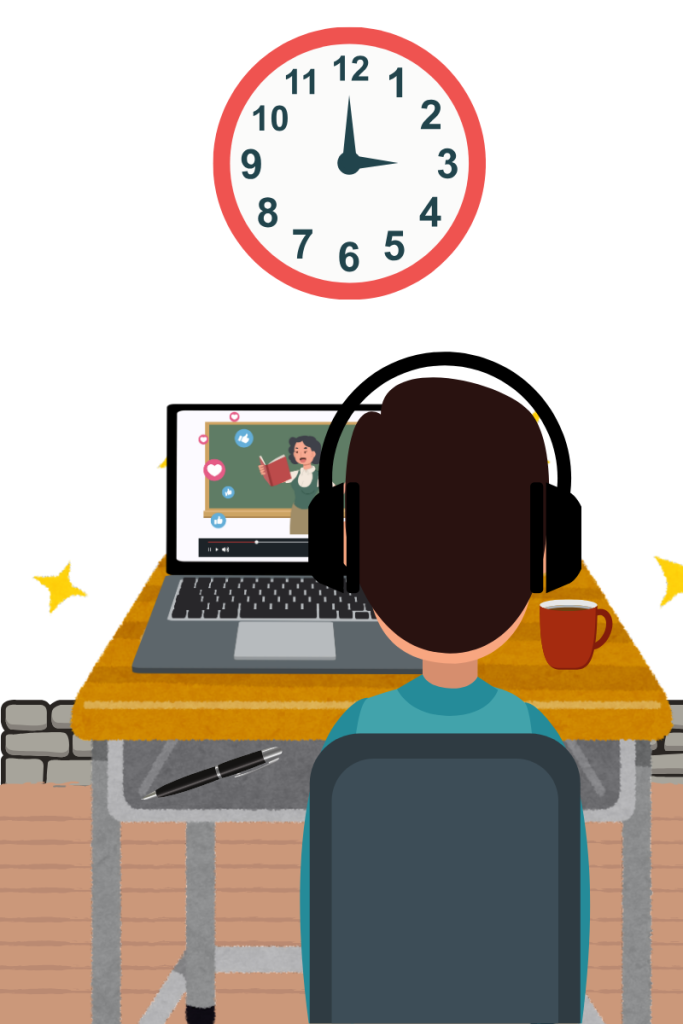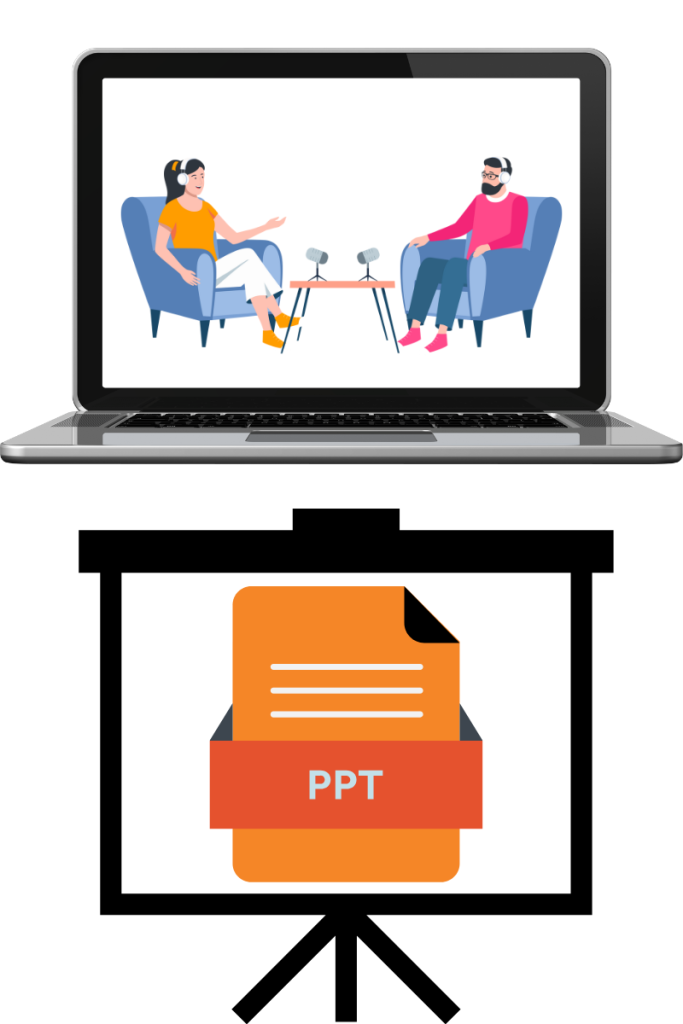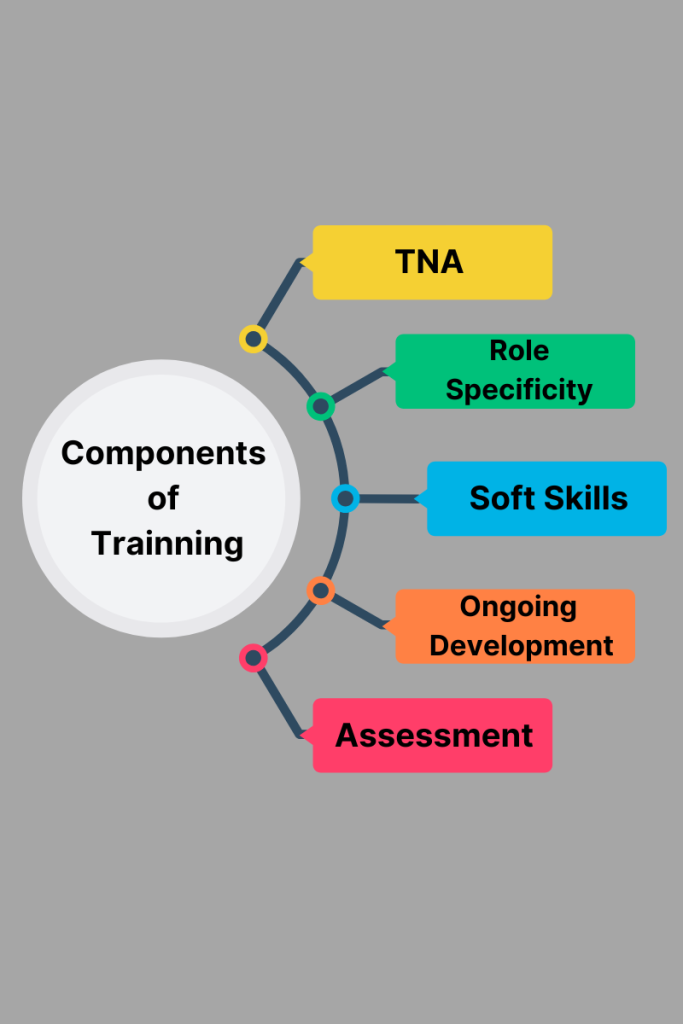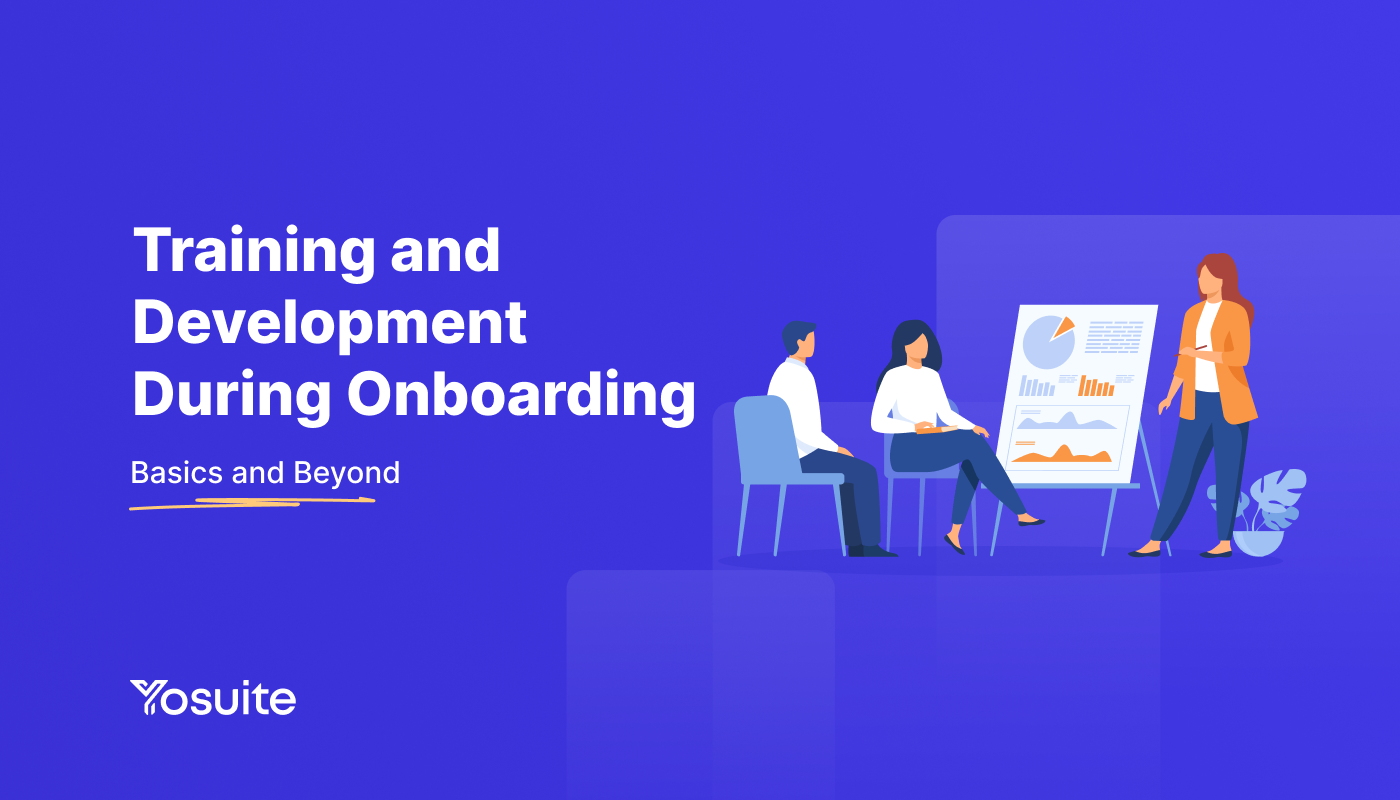Training and Development during onboarding is more than a formality nowadays. It’s a vital process that shapes new employees’ experiences, productivity, and overall engagement during their tenure with the organization.
Integrating well-structured training and development initiatives during the onboarding phase can help employees transition smoothly into their roles, understand company culture, and build the skills they need to thrive.
In this post, we’ll explore the significance of training and development during onboarding, its benefits to both employees and organizations and some effective strategies for implementing a successful onboarding program.
Table of Contents
Understanding Training and Development During Onboarding
Training employees comes in various forms and methods. And it is a different ball game altogether when it comes to training them during their first few months or days with the company.
Prioritizing employee training and development opportunities from the start of one’s job tenure helps them improve their daily on-the-job performance and gives them the skills needed to try new roles down the line.
The initiative lets employers enhance the odds of retaining top performers in the long term.
Some key reasons why training and development are important during the onboarding phase are:
Enhancing Knowledge, Skills, and Abilities
New employees often come from diverse backgrounds with varying skill levels, making training essential to bridge the knowledge, skills, and abilities (KSAs) gaps.
For instance, an employee with less than a year of experience will need a stronger mix of generic business training and job-specific training as compared to a new hire for a managerial role with 5+ years of experience.
Role-specific onboarding training can ensure everyone is on the same page regarding skills, tools, and industry knowledge, helping employees contribute effectively from the very beginning.
Increasing Engagement and Retention
Studies show that employees who feel adequately trained are more engaged and likely to stay with an organization longer. By investing in their development early on, companies demonstrate a commitment to their growth and success, creating a sense of belonging and loyalty.
According to a survey by Axionify, around 92% of employees believe that well-planned training programs yield favorable results on their level of engagement.
Accelerating Time-to-Productivity
An effective training program equips employees with the information and skills they need to succeed in their roles. This reduces the time required for them to reach full productivity, enabling faster contributions to team and company goals.
For example, an employee receiving exposure to his work duties on each of the first five days of his first work week will help him become familiar with the task nature. It will also help him tackle difficult situations in the coming days, as he will feel more comfortable.
Promoting Cultural Alignment
Training during onboarding also serves as a way to communicate the company’s values, mission, and cultural expectations. When employees understand and align with the organization’s culture, they are more likely to engage meaningfully and contribute to a positive work environment.
Sharing resources on the corporate values, introducing company culture, and taking tests on these aligns the new hire with the company faster. Or at least it lets him decide whether company requirements align with his career goals.
Effective Onboarding Practices
Creating Structured Onboarding Programs
An effective onboarding training programs create a clear roadmap for new employees. Consider creating a 30-60-90 day plan that outlines specific goals and training sessions at each stage. This gives employees a sense of progression and measurable milestones to work towards.
A sample program could be as follows:
First 30 Days: Onboarding and Orientation
The goals might be to:
- Understand the company mission, values, and culture.
- Familiarize with the team, tools, and workflows.
- Complete initial training sessions.
The new hires would be assessed on:
- Completing the onboarding checklist.
- Gaining a basic understanding of job responsibilities and company structure.
Days 31-60: Skill Development and Integration:
Goals will include:
- Applying knowledge gained from training in real tasks.
- Developing relationships with team members and cross-functional departments.
- Continuing learning and asking for feedback.
The assessment would be on :
- Successfully complete a minor project or task.
- Receive and incorporate feedback from the manager and peers.
- Demonstrate a deeper understanding of role-specific tools and processes.
Days 61-90: Performance and Feedback:
Goals would include:
- Fully owning projects and responsibilities.
- Contributing to team goals and participating in strategic planning.
- Demonstrating independent problem-solving and initiative.
Milestones of the new joiners:
- Successfully complete a major project or initiative.
- Show consistent, independent performance.
- Establish a development plan for the next 6 months or years.
The above is a walkthrough of a sample 30-60-90 day structured onboarding program with various training initiatives. But you can develop programs that suit your needs.
Offering a Blended Learning Approach
You can use a mix of online and offline training sessions, known as a blended learning approach. This allows for flexibility and accommodates different learning styles. E-learning modules can be combined with live workshops, interactive sessions, and hands-on training, providing a comprehensive learning experience.
Let’s look at some examples:
E-Learning Modules for Flexibility
New hires complete an online module on company policies and compliance at their own pace. This allows them to absorb essential information without the pressure of a fixed schedule.
A technical team member might use interactive simulations to learn software applications or troubleshoot common issues.
Employees can revisit the content as needed, ensuring thorough understanding and retention.
Live Workshops for Engagement
After completing an online module on communication skills, employees attend an in-person workshop where they practice these skills through role-playing exercises and group discussions.
Sales teams participate in live webinars where they can ask questions and interact with experts, deepening their understanding of advanced sales strategies.
Interactive sessions enhance engagement and provide immediate feedback, fostering a deeper connection to the material.
Hands-On Training for Practical Application
After an online safety course, employees participate in a hands-on lab where they practice using safety equipment and responding to simulated emergencies.
An IT team, after completing a virtual cybersecurity course, engages in a live, in-person exercise to identify and mitigate a mock security breach.
Real-world application helps solidify learning, ensuring that employees are confident and capable in their roles.
Interactive Sessions for Collaboration
A hybrid model could include weekly virtual check-ins via video conferencing, where employees discuss what they’ve learned from online courses and share insights with peers.
Project management trainees might engage in collaborative group projects that mix virtual brainstorming sessions with face-to-face presentations.
This encourages collaboration and teamwork, creating a community of learners who support each other’s growth.

Gamification of Training
Gamification integrates game-like elements into training, making the learning process more engaging and motivating. By using tools like badges, quizzes, and leaderboards, employees are encouraged to actively participate and complete training modules. This approach is particularly appealing to younger, digitally-native employees who thrive on interactive experiences.
For example, employees can earn digital badges for completing specific training milestones, such as finishing an e-learning module or mastering a new skill. Through skills development in onboarding, a customer service representative might earn a “Conflict Resolution Master” badge after completing a course on handling difficult customer interactions.
This provides a tangible sense of accomplishment, motivating employees to progress through the training.
Let’s say after completing a training module on cybersecurity, employees take a quiz that tests their understanding of the key concepts. Interactive quizzes with immediate feedback help learners identify areas where they need improvement.
To add an element of fun, quizzes could include time-based challenges where employees compete to answer questions quickly and accurately.
The benefit the new hire receives here is that it reinforces learning by encouraging active recall and providing instant feedback on performance.
Again, using a leaderboard allows you to track employee progress and scores in a sales training program. Those who complete modules faster or score higher on quizzes move up the ranks. Top performers could be recognized weekly or monthly, fostering friendly competition.
In a retail setting, employees might compete to see who can complete product knowledge quizzes the fastest, with the leaderboard displayed on the company intranet.
KPIs set through gamification can be development goals during onboarding. This ensures a way to measure the progress of the new hires.
Assigning Mentors or Buddies
Mentorship plays a crucial role in helping new hires feel supported and confident. A mentor or buddy can provide insights, answer questions, and offer guidance during the onboarding process. These relationships also help new employees build connections within the organization, aiding long-term retention.
Incorporating a buddy system into onboarding creates a smoother transition for new hires. Introducing the buddy during pre-boarding is a great strategy. You can send a welcome message or introductory email outlining the buddy’s role to help set the tone.
Alternatively, arranging a virtual or in-person meeting before the start date gives the new hires immediate support and more comfort.
Establishing weekly or bi-weekly check-ins or follow-ups helps to keep up with the progress of the new joiner. These can range from informal chats to structured sessions, depending on the new hire’s needs.
The activities that you plan should be varied, and help the new hires integrate socially and culturally. Some activities could be:
- Virtual coffee chats for Q&A.
- Team lunches for broader introductions.
- Virtual office tours or team-building exercises.
- Joint participation in company or industry events.
But you should make sure to match buddies and new hires based on shared interests, similar backgrounds, or complementary skills to enhance compatibility and support.
By embedding these steps, the buddy system can greatly enhance the onboarding experience, making new hires feel welcomed and engaged from the start.

Personalized Training Paths
Every employee has unique strengths and areas for improvement. Personalized training paths allow organizations to tailor the onboarding experience to each employee’s skill level and career goals. This might include one-on-one coaching sessions, specialized e-learning content, or project-based learning for skill enhancement.
Here, we will discuss three types of learning that new hires can avail:
Visual Learning
This type of learning is based on videos, imagery, diagrams, and written content. Some effective ways you can incorporate visual learning into training are:
- Infographics: These are powerful materials for distilling complex ideas into easily understandable visuals. By combining text, images, and design elements, they present data or concepts in a way that is both engaging and educational. As per recent reports, infographics are 30 times more likely to be read than written text content.
- Video Tutorials: Engaging and easy to follow, videos can be paused and revisited as needed. Their flexibility makes them particularly appealing. For instance, if you enroll a new hire into one of LinkedIn’s Learning Paths, it would be both engaging and easy to grasp for the trainee.
- Slide Decks: Organized, visually appealing slides enhance comprehension during workshops or presentations. Slide decks, commonly used in workshops and presentations, are effective because they provide a clear, organized framework for conveying information. Modern slide decks often include interactive elements such as embedded videos, quizzes, or clickable links, which can increase participant engagement and provide immediate feedback.

Auditory Learning
Auditory learners thrive when they can hear information, as they process and retain knowledge most effectively through listening. To optimize training for these individuals, organizations can leverage several auditory-friendly methods:
- Podcasts: These forms of content have become a popular medium for delivering educational content due to their flexibility and depth. Podcasts often dive deep into specific topics, providing comprehensive insights that may not be feasible in shorter training formats. From industry trends to soft skills development, podcasts can cover a wide array of subjects tailored to different roles and interests within the organization. There are many valuable podcasts, free of cost, on YouTube.
- Webinars: Webinars are versatile tools for real-time or on-demand learning. During live sessions, participants can ask questions, engage in discussions, and get immediate feedback from the presenters, enhancing the learning experience. Webinars often feature industry experts or internal leaders, allowing learners to gain valuable insights directly from experienced professionals.
- Discussion Groups: These groups encourage employees to articulate their thoughts and ideas, reinforcing their understanding of the material through verbal expression. Facilitators or fellow group members can offer instant feedback or clarification, helping learners to quickly resolve any issues.
Kinesthetic Learning
The third type of learners, Kinesthetic learners, prefer hands-on experiences and active participation. This style can be supported through:
- Role-playing: Simulating real-world scenarios helps employees practice and refine their skills.
- Simulation Games: Interactive games provide a safe environment for experimenting and learning from mistakes.
- Field Trips/Tours: Visiting different departments or observing processes in action enhances practical understanding.
Investing in personalized, role-specific training boosts the future of your organization. By providing employees with the tools they need to succeed, businesses can unlock the full potential of their teams, fostering growth, innovation, and success.
Components of a New Hire Training Process
To maximize the impact of training and development in onboarding, it’s crucial to incorporate several key elements into the structured onboarding training program:
➡️ Training Needs Assessment (TNA)
Training Needs Assessment (TNA) is a systematic process used to identify the specific skills, knowledge gaps, and developmental needs of employees to tailor training programs effectively.
During the onboarding of new hires, TNA plays a crucial role in ensuring that the training provided aligns with the individual’s existing skills and the organization’s objectives.
By assessing what new employees already know and what they need to learn, TNA helps in designing role-specific training processes that maximize learning efficiency, enhance engagement, and accelerate the transition into their new roles.
➡️ Role-Specific Training
Every position requires a unique set of skills and knowledge. You should design training programs for each role to cover essential tools, processes, and responsibilities. This may include hands-on training, shadowing, or mentoring sessions based on the functional requirements.
For instance, an IT engineer’s training during onboarding should only focus on specific programming languages and/or hardware troubleshooting skills.
➡️ Soft Skills and Cultural Orientation
While technical skills are vital, soft skills such as communication, problem-solving, and teamwork are equally important. Training sessions should include activities that strengthen these skills while emphasizing the company’s values, mission, and culture.
➡️ Ongoing Development and Resources
The onboarding phase should provide new hires with resources for continued learning. This may include access to an online learning portal, an assigned mentor, or periodic workshops that cover advanced topics.
By offering avenues for continuous growth, companies reinforce their commitment to employee development.
A great example is Google which focuses on comprehensive training for new employees with an emphasis on continuous learning, offering tools like “GoogleEDU” for personal skill development.
➡️ Assessment and Feedback Mechanisms
To ensure that training is effective, it’s essential to incorporate assessments and feedback loops. This could include quizzes, practical assignments, or feedback sessions where new employees can share their thoughts on the training process.
Regular feedback allows organizations to refine their training programs and ensures that new hires are absorbing critical information.

Benefits of a Structured Onboarding Program
So, what are the benefits of employee development during onboarding ?
✅ Skill Enhancement and Continuous Learning
Onboarding offers a prime opportunity to introduce new hires to a learning-oriented culture. With targeted training, employees can build on existing competencies and learn new skills, promoting a culture of continuous improvement and adaptability.
According to a recent report by Training Industry, a remarkable 94% of employees indicated they would stay at a company longer if it invested in their career development. This shows the significant impact that continuous learning can have on employee retention.
✅ Building Confidence and Reducing Anxiety
Starting a new job can be intimidating, but comprehensive training gives employees the confidence they need to succeed. When they feel well-prepared, new hires are less likely to experience overwhelming stress and more likely to feel comfortable asking questions and engaging in tasks early on.
A study by Emerald Insights shows that when an employee’s skills match his/her job, they feel more confident doing it. And to ensure that, training initiatives are paramount.
✅ Supporting Team Integration and Collaboration
Structured training can include collaborative projects or team-based exercises that encourage new hires to work alongside existing team members. This approach facilitates relationship building and allows new employees to understand team dynamics and communication protocols.
✅ Enhancing Job Satisfaction and Reducing Turnover
When employees feel equipped and empowered through effective training, they are more likely to find job satisfaction. This satisfaction leads to higher engagement levels, which in turn reduces turnover rates—saving organizations significant time and resources in hiring and training replacements.
Measuring the impact of onboarding training programs
Assessing the effectiveness of onboarding training is essential for making continuous improvements. Here are some metrics to track the effectiveness of your T&D efforts:
- Time-to-Productivity: Measure how quickly new hires achieve proficiency in their roles.
- Retention Rates: Evaluate whether employees who complete onboarding stay with the company longer than those who don’t.
- Employee Satisfaction and Engagement: Use surveys to gauge new hires’ satisfaction with the onboarding process and their engagement level.
- Performance Assessments: Review new hires’ performance metrics at regular intervals to assess how well training has prepared them.
- Feedback from New Hires: Collect direct feedback from employees who recently completed onboarding to identify areas for improvement.
Training Checklist for Onboarding
Before we wrap up, here is a training checklist to help you create a successful onboarding experience, starting from pre-onboarding to three months into the new hire’s tenure:
Pre-Arrival:
- Send welcome materials and company information.
- Set up workspace and necessary equipment.
Day 1:
Company Overview
- Introduction to the Company
- Department Overview:
- Product Familiarization:
- Takeaway Materials
Policy Orientation
- Key Workplace Policies
- Leave Entitlements
- Performance Reviews
- Confidentiality Agreements
- Policy FAQs
Benefits & Compensation Overview
- Insurance Plans
- Flexible Work Options
- Development Opportunities
- Perks
First week
Role-Specific Training
- Daily Responsibilities:
- Tool Introduction:
- Resource List:
- Team Dynamics
- KPI Discussions
- Regular follow-ups:
IT Setup
- Account Access:
- Data Privacy:
- System Configuration:
- Security Training:
First Month
Security Training
- Training Modules
- Remote Access Setup
- Workstation Safety
- Community Support
Safety Training
- Emergency Procedures
- First Aid
- Hazardous Materials
- Ergonomic Practices
First 3 months
Skills Training
- Identify Core Skills
- Begin Hands-On Projects
- Intermediate Training Modules
- Skill Application Review
- Advanced Skill Development
- Final Project Assignment
- Comprehensive Review:
- Feedback Sessions
Summing Up
Training and development during onboarding is crucial for equipping new employees with the skills, knowledge, and confidence they need to succeed. Effective onboarding programs that prioritize training foster a culture of learning, enhance employee satisfaction, and improve retention rates. Take note that utilizing AI in employee onboarding and AI-powered training tools can speed up and can make the whole process a lot easier.
By investing in robust training initiatives from the start, organizations not only empower their employees but also set a strong foundation for future success. A well-executed onboarding program is an investment that delivers lasting returns for both the employee and the organization.
Implementing these strategies requires careful planning and commitment, but the results—a thriving, well-prepared workforce—are well worth the effort.

Leave a Reply